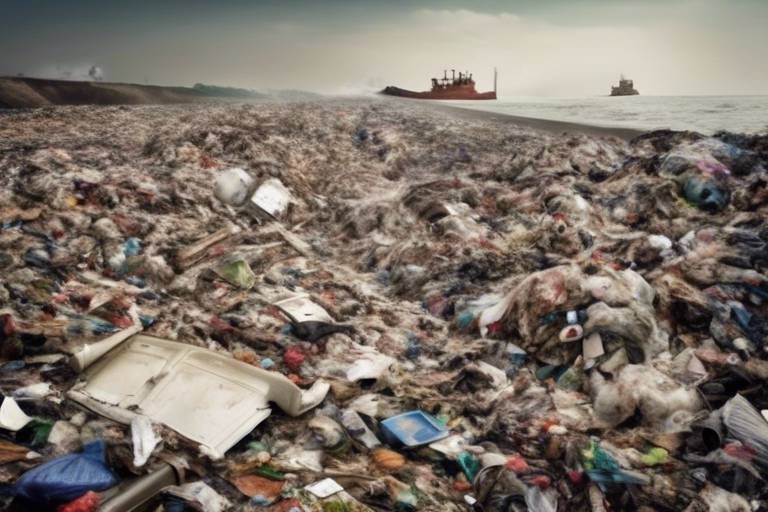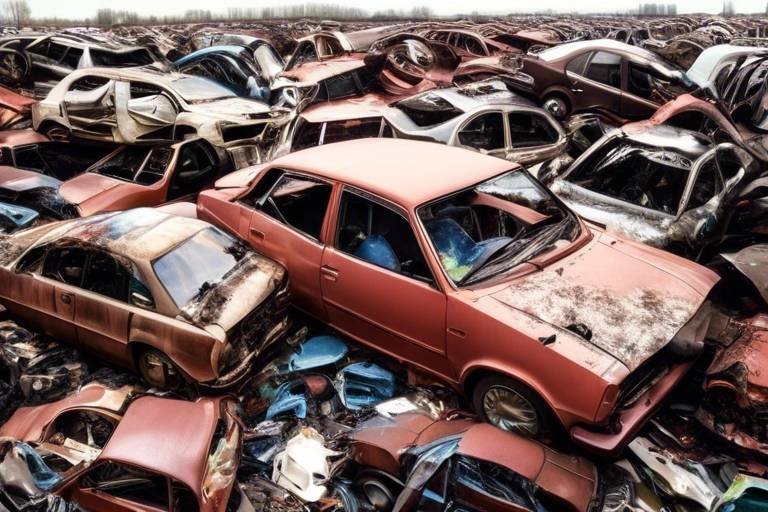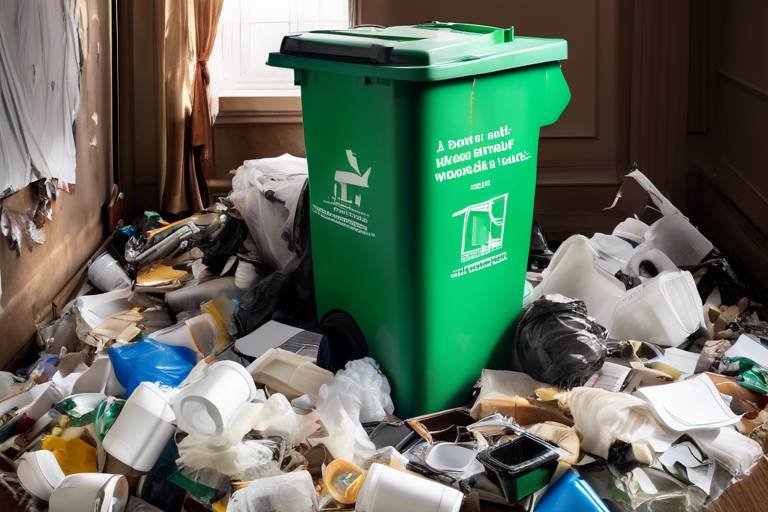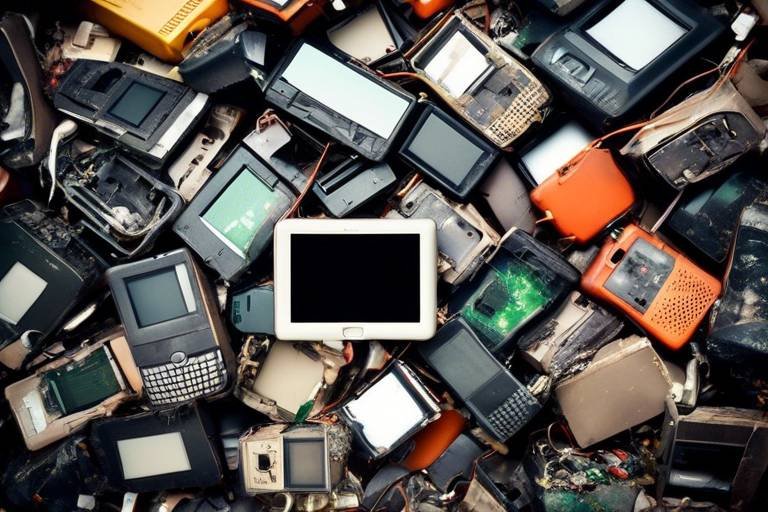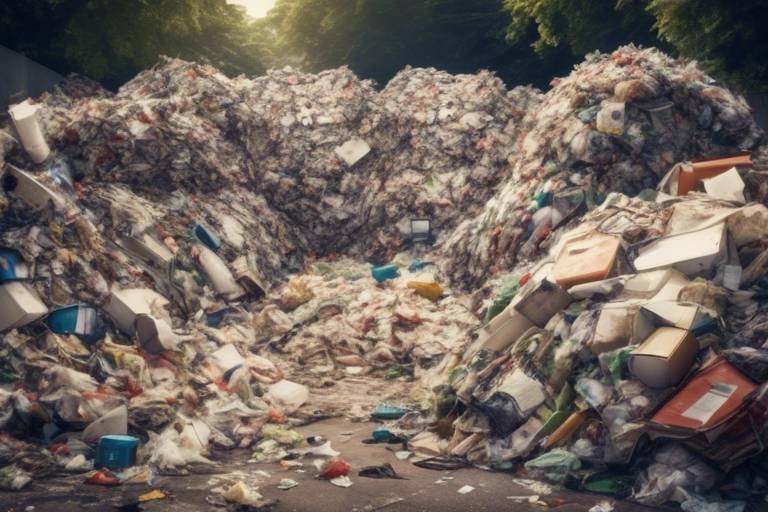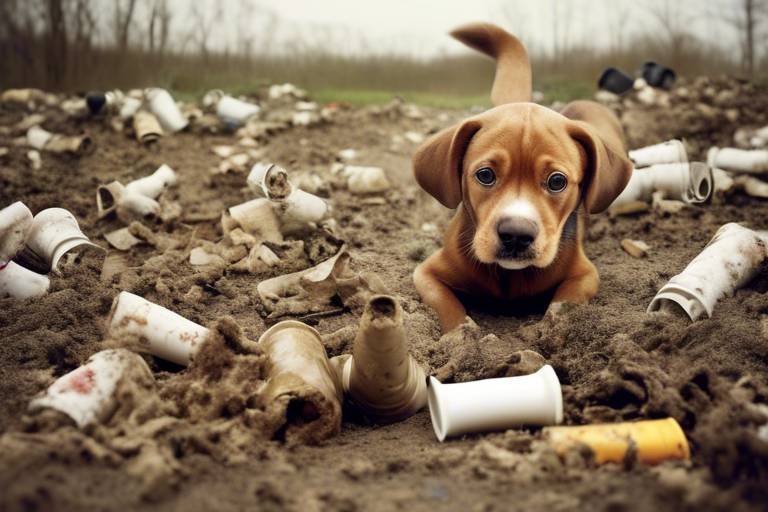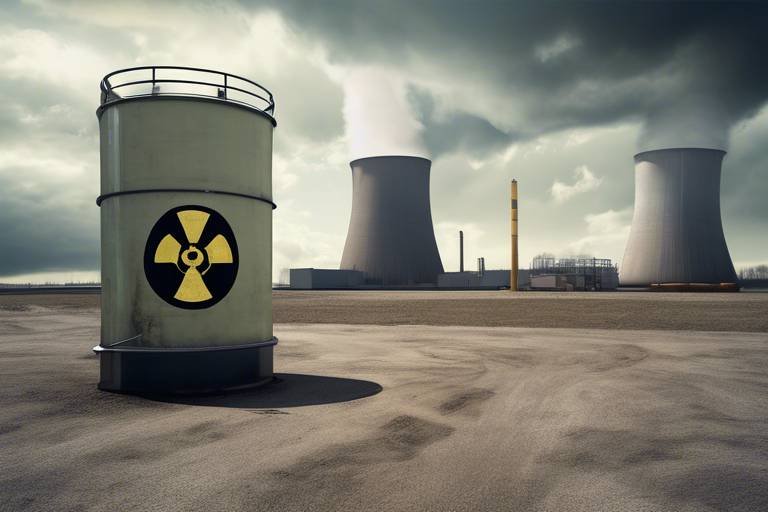Global Waste - A Fight We Cannot Ignore
In today's world, the issue of global waste has reached alarming proportions, and it’s a fight we simply cannot ignore. Every day, millions of tons of waste are generated, and the impact of this waste is felt across the globe. From overflowing landfills to polluted oceans, the consequences of our wasteful habits are dire. But what exactly is driving this crisis? And more importantly, what can we do about it? This article delves deep into the pressing issue of global waste, examining its causes, consequences, and potential solutions. Together, we will explore various aspects of waste management and the environmental impact that demands our urgent attention.
To truly understand the gravity of the global waste crisis, we must first grasp the scale of the problem. According to recent statistics, it is estimated that the world generates over 2.01 billion tons of municipal solid waste annually, and this figure is projected to rise to 3.4 billion tons by 2050 if current trends continue. So, what types of waste are we producing? The breakdown is staggering:
| Type of Waste | Percentage of Total Waste |
|---|---|
| Organic Waste | 44% |
| Plastic Waste | 12% |
| Paper and Cardboard | 17% |
| Metal | 5% |
| Glass | 4% |
| Other | 18% |
This table clearly illustrates the composition of global waste, highlighting the overwhelming presence of organic waste and the growing concern of plastic pollution. The trends observed in recent years show a marked increase in plastic waste, driven by our reliance on single-use plastics and convenience products. It’s a vicious cycle that not only threatens our environment but also our health and future.
The environmental ramifications of waste accumulation are severe and far-reaching. Waste doesn’t just disappear; it affects ecosystems, contributes to pollution, and exacerbates climate change. For instance, when waste decomposes in landfills, it produces methane, a greenhouse gas that is significantly more potent than carbon dioxide. This contributes to global warming and climate change, which in turn leads to extreme weather patterns and loss of biodiversity.
Moreover, our oceans are becoming dumping grounds for plastic waste, with an estimated 8 million tons of plastic entering the oceans each year. This not only harms marine life but also disrupts entire ecosystems. Fish ingest plastic particles, which then enter the food chain, posing a risk to human health as well. The cycle of waste is a cycle of destruction, and if we continue on this path, the consequences will be catastrophic.
Improper waste management poses significant health risks to communities, particularly in vulnerable populations. Exposure to hazardous waste can lead to serious health issues such as respiratory problems, skin diseases, and even cancer. Furthermore, communities near landfills often suffer from foul odors and contaminated water sources, leading to a lower quality of life.
In developing countries, the situation is even more dire. Many people live in close proximity to waste dumps, where they scavenge for recyclable materials. This not only exposes them to toxic substances but also puts them at risk of injury. As we can see, the health implications of waste exposure are profound and demand immediate action.
As the crisis deepens, innovative approaches to waste management are essential for mitigating the problem. Solutions such as waste-to-energy technologies, composting, and advanced recycling processes are gaining traction. For instance, some cities are implementing smart waste management systems that utilize technology to optimize waste collection and recycling efforts. These initiatives not only reduce waste but also promote sustainability.
Successful case studies from around the world demonstrate that with the right strategies, we can turn waste into a resource. For example, Sweden has become a leader in waste management, recycling nearly 99% of its waste, much of which is converted into energy. This is a prime example of how innovative thinking can lead to effective waste solutions.
Government policies play a pivotal role in waste management. Existing regulations often fail to address the complexities of the waste crisis. To foster sustainable waste practices globally, we need comprehensive policy changes that prioritize waste reduction, recycling, and responsible disposal methods. This includes implementing stricter regulations on plastic production and encouraging businesses to adopt sustainable practices.
Community involvement is vital for effective waste management. Initiatives aimed at educating the public and encouraging grassroots movements can significantly impact waste reduction efforts. When communities come together to tackle waste issues, they can create lasting change. Education campaigns can raise awareness about the importance of recycling, composting, and reducing single-use plastics.
The circular economy offers a sustainable alternative to traditional waste management. By redesigning products and systems to minimize waste, we can create a more sustainable future. The principles of a circular economy emphasize reusing, recycling, and repurposing materials, thereby reducing the amount of waste generated. This shift in mindset is crucial for addressing the global waste crisis.
Businesses have a critical role in waste reduction efforts. By adopting sustainable practices and corporate social responsibility initiatives, companies can minimize their waste footprint. This not only benefits the environment but also enhances their brand reputation and customer loyalty. It’s a win-win situation that more businesses need to embrace.
Looking ahead, emerging trends and technologies in waste management could revolutionize how we approach waste. The integration of artificial intelligence in waste sorting and recycling processes is an exciting development. Additionally, the use of sustainable materials in product design can significantly reduce waste generation. By staying ahead of these trends, we can pave the way for a cleaner, more sustainable future.
- What is the biggest contributor to global waste? - The biggest contributor is organic waste, which constitutes about 44% of total waste generated.
- How can individuals help reduce waste? - Individuals can reduce waste by recycling, composting, and minimizing the use of single-use plastics.
- What are the health risks associated with waste? - Improper waste management can lead to respiratory problems, skin diseases, and other serious health issues.
- What is the circular economy? - The circular economy is a model that focuses on reusing, recycling, and repurposing materials to minimize waste.

The Scale of Global Waste
Understanding the sheer volume of waste generated worldwide is crucial to grasping the magnitude of this pressing issue. Did you know that, according to the World Bank, global waste generation is projected to reach a staggering 3.4 billion tons by 2050? That's a jaw-dropping figure that highlights the urgent need for action. In recent years, we've observed a worrying trend: as populations grow and urban areas expand, so does the amount of waste we produce. This isn't just about trash; it encompasses various types of waste, including municipal solid waste, organic waste, plastics, and hazardous materials. Each category presents its own set of challenges that we must confront.
To give you a clearer picture, let’s break down some of the key statistics:
| Type of Waste | Estimated Annual Generation (in million tons) |
|---|---|
| Municipal Solid Waste | 2,000 |
| Plastic Waste | 300 |
| Organic Waste | 1,300 |
| Hazardous Waste | 400 |
As you can see from the table, municipal solid waste alone accounts for a significant portion of global waste. But what does this mean for our planet? With such massive quantities of waste being generated, our landfills are overflowing, and many communities are struggling to manage this burden effectively. The consequences are dire; waste doesn't just disappear. It leaches toxins into the soil, pollutes our waterways, and contributes to greenhouse gas emissions, which are driving climate change.
In many developing countries, the situation is even more alarming. Poor waste management practices lead to heaps of garbage in the streets, creating unsanitary conditions that can foster disease. The lack of infrastructure, combined with rapid urbanization, makes it incredibly challenging to keep up with waste disposal needs. In contrast, developed nations, while better equipped, still face significant challenges in reducing their waste footprints and increasing recycling rates.
So, what can we do about this? It starts with awareness. The more we understand the scale of global waste, the more motivated we become to seek solutions. Whether it’s reducing our own waste output, advocating for better policies, or supporting innovative waste management technologies, every action counts. Remember, the fight against waste is not just a personal responsibility; it's a collective challenge that requires us all to step up and take action.

Impact on the Environment
The environmental ramifications of waste accumulation are profound and far-reaching. Every piece of waste that we generate does not simply vanish; it has a ripple effect that can disrupt ecosystems, pollute our air and water, and even contribute to the ongoing crisis of climate change. Imagine, for a moment, a world where every discarded item—be it plastic, food scraps, or electronic devices—finds its way into our oceans, landfills, and natural habitats. The consequences are alarming and demand our immediate attention.
To put things into perspective, consider the following statistics:
| Type of Waste | Annual Global Production (in billion tons) |
|---|---|
| Municipal Solid Waste | 2.01 |
| Industrial Waste | 7.6 |
| Agricultural Waste | 1.3 |
| Electronic Waste | 0.05 |
As you can see, the sheer volume of waste generated each year is staggering. But what does this mean for our environment? First and foremost, waste contributes to pollution in various forms. When waste decomposes in landfills, it produces methane, a greenhouse gas that is significantly more potent than carbon dioxide. This gas escapes into the atmosphere, exacerbating climate change. Furthermore, waste incineration releases toxic substances that can contaminate air quality and contribute to respiratory issues among nearby populations.
Additionally, plastic waste poses a unique threat to marine life. Every year, millions of tons of plastic end up in our oceans, leading to devastating consequences for aquatic ecosystems. Sea turtles mistake plastic bags for jellyfish, while fish and birds ingest microplastics, which can accumulate in their bodies and disrupt their reproductive systems. The impact on biodiversity is catastrophic, leading to a decline in species populations and the disruption of food chains.
Moreover, waste accumulation can lead to soil contamination. Hazardous waste, such as chemicals and heavy metals, can leach into the ground, making it unsafe for agriculture and harming local wildlife. This contamination not only affects the immediate area but can also spread to larger ecosystems, creating long-term damage.
In summary, the impact of waste on the environment is a multifaceted issue that requires urgent action. From pollution to biodiversity loss, the consequences of our wasteful habits are evident. It is crucial for us to recognize that every piece of waste we generate has the potential to harm our planet. By understanding these impacts, we can begin to take steps toward more sustainable practices and advocate for change on both individual and systemic levels.
- What are the main types of waste that impact the environment? The main types include municipal solid waste, industrial waste, agricultural waste, and electronic waste.
- How does waste contribute to climate change? Waste decomposition in landfills produces methane, a potent greenhouse gas that contributes to global warming.
- What can individuals do to reduce waste? Individuals can reduce waste by recycling, composting, and choosing sustainable products.
- Why is plastic waste particularly harmful to marine life? Marine animals often mistake plastic for food, leading to ingestion that can harm their health and disrupt ecosystems.

Health Risks Associated with Waste
When we think about waste, we often picture overflowing landfills or littered streets, but the implications of waste extend far beyond mere aesthetics. The health risks associated with improper waste management are alarming and can have devastating effects on communities, particularly among vulnerable populations such as children and the elderly. The accumulation of waste can lead to a variety of health problems, ranging from respiratory issues to severe infections. But how exactly does waste impact our health?
One of the most significant health risks arises from toxic substances present in waste. Many discarded materials contain hazardous chemicals that can leach into the soil and groundwater, leading to contamination. For instance, heavy metals like lead and mercury found in electronic waste can cause neurological issues and other serious health problems when they enter the food chain. Furthermore, waste sites often attract pests, such as rats and insects, which can carry diseases. According to the World Health Organization, improper waste disposal contributes to the spread of diseases such as cholera and dengue fever.
Moreover, the burning of waste, a common practice in many regions, releases harmful pollutants into the air. These emissions can exacerbate respiratory conditions, including asthma and bronchitis, affecting not just those living near waste incinerators but also the broader population. The particulate matter and toxic fumes released can lead to long-term health complications, raising the question: how many lives are at risk because of our waste management practices?
In addition to physical health risks, there are also mental health implications associated with living in areas burdened by waste. The sight and smell of waste can lead to feelings of stress and anxiety. Communities with poor waste management often experience a sense of neglect, which can contribute to social issues and deteriorating mental well-being. It's essential to recognize that waste management is not just an environmental issue; it's a public health crisis that demands our immediate attention.
To illustrate the severity of these health risks, consider the following table that highlights some common health issues linked to waste exposure:
| Health Issue | Cause | Population Affected |
|---|---|---|
| Respiratory Diseases | Air pollution from burning waste | All ages, especially children and elderly |
| Infections | Vector-borne diseases from pests | Vulnerable populations |
| Neurological Disorders | Heavy metals in contaminated soil and water | Children and pregnant women |
| Stress and Anxiety | Visual and olfactory pollution | Community residents |
Addressing these health risks is not just about improving waste management practices; it's about ensuring the well-being of our communities. Engaging in proper waste disposal, recycling, and advocating for better policies can significantly reduce these health hazards. We must recognize that every piece of waste we generate has the potential to impact our health and the health of those around us.
- What are the most common health risks associated with waste? Common health risks include respiratory diseases, infections from pests, neurological disorders due to heavy metal exposure, and mental health issues from living in polluted environments.
- How does waste management affect public health? Poor waste management can lead to environmental contamination, which in turn can cause a range of health problems for the community, particularly for vulnerable groups.
- What can communities do to mitigate these health risks? Communities can engage in proper waste disposal practices, participate in recycling programs, and advocate for better waste management policies at local and national levels.

Innovative Waste Management Solutions
As we grapple with the escalating crisis of waste management, it's clear that traditional methods are no longer sufficient. We need to embrace that not only address the growing volumes of waste but also actively promote sustainability. One of the most exciting developments in this arena is the rise of smart waste management technologies. Imagine a world where waste bins are equipped with sensors that notify waste collection services when they are full, optimizing collection routes and reducing fuel consumption. This is not just a futuristic dream; it's happening now in cities around the globe!
Additionally, biodegradable materials are gaining traction as a viable alternative to conventional plastics. These materials break down naturally, significantly reducing landfill contributions. For example, companies are now producing bioplastics from organic materials, such as corn starch, which can decompose within a few months. This innovation not only helps in reducing waste but also lessens the demand for petroleum-based products, making it a win-win for the environment.
Moreover, the concept of upcycling has emerged as a creative solution to waste. Upcycling transforms waste materials into new products of better quality or for better environmental value. For instance, old tires can be repurposed into stylish furniture or playground surfaces, diverting them from landfills while providing unique and functional items. This approach not only minimizes waste but also fosters a culture of creativity and sustainability.
Another promising area is the use of waste-to-energy technologies. These systems convert non-recyclable waste materials into usable energy, such as electricity, heat, or fuel. By harnessing the energy potential of waste, we can significantly reduce landfill use while generating power. Countries like Sweden have already implemented successful waste-to-energy plants that process waste and provide heating for thousands of homes, showcasing the potential of this approach.
Furthermore, community-driven initiatives are playing a crucial role in innovative waste management. Local groups are organizing clean-up drives, educational workshops, and recycling programs that empower individuals to take action. These grassroots movements not only raise awareness but also foster a sense of community responsibility towards waste management.
To illustrate the impact of these innovative solutions, consider the following table that highlights some successful case studies:
| City | Solution Implemented | Impact |
|---|---|---|
| San Francisco | Zero Waste Program | Achieved a diversion rate of over 80% from landfills |
| Amsterdam | Smart Waste Bins | Reduced collection costs by 30% |
| Capannori, Italy | Door-to-Door Recycling | Increased recycling rates to over 40% |
In conclusion, the path to effective waste management is paved with innovation. By adopting new technologies and fostering community engagement, we can tackle the waste crisis head-on. The solutions are out there, waiting for us to implement them. Are we ready to embrace these changes and make a significant impact on our planet?
Q: What are some examples of innovative waste management solutions?
A: Some examples include smart waste bins, biodegradable materials, upcycling initiatives, and waste-to-energy technologies.
Q: How can communities get involved in waste management?
A: Communities can organize clean-up drives, educational workshops, and recycling programs to raise awareness and promote responsible waste practices.
Q: What is upcycling?
A: Upcycling is the process of transforming waste materials into new products of better quality or value, helping to reduce waste and promote creativity.
Q: How does waste-to-energy technology work?
A: Waste-to-energy technology converts non-recyclable waste into usable energy, such as electricity or heat, thereby reducing landfill use and generating power.

The Role of Legislation and Policy
The fight against global waste is not just a grassroots movement; it requires robust legislation and effective policies to drive meaningful change. Governments around the world have a pivotal role in shaping how waste is managed, and this influence can either hinder progress or catalyze innovative solutions. Laws and regulations can set the groundwork for waste reduction, recycling, and responsible disposal practices, but their effectiveness often hinges on the commitment of both policymakers and the public.
One of the most significant challenges in waste management legislation is the inconsistency across different regions. For instance, while some countries have implemented strict regulations on plastic use and waste disposal, others lag behind, resulting in a patchwork of policies that can confuse businesses and consumers alike. This lack of uniformity can lead to ineffective waste management practices, where waste generated in one area is poorly handled in another, contributing to environmental degradation. To illustrate this point, consider the following table that outlines various countries and their corresponding waste management policies:
| Country | Policy Type | Key Regulation |
|---|---|---|
| Germany | Recycling | Packaging Act |
| Sweden | Landfill Ban | Waste Management Act |
| United States | State-Level Initiatives | Varies by State |
| Japan | Waste Separation | Waste Management and Public Cleansing Law |
Moreover, effective legislation should not only focus on waste management but also emphasize prevention and reduction. This is where the concept of Extended Producer Responsibility (EPR) comes into play. EPR policies make manufacturers responsible for the entire lifecycle of their products, including what happens after they are discarded. By incentivizing companies to design products that are easier to recycle or dispose of, we can significantly reduce the volume of waste that ends up in landfills.
However, legislation alone is not enough. It must be coupled with public awareness campaigns and education initiatives to ensure that communities understand the importance of compliance and the environmental impact of their actions. For instance, when people are educated about the benefits of recycling and the consequences of littering, they are more likely to participate in waste reduction efforts. This is where community engagement becomes essential, as it fosters a culture of responsibility and accountability.
Furthermore, the role of international agreements cannot be overlooked. Treaties like the Basel Convention, which aims to reduce the movement of hazardous waste between nations, highlight the need for global cooperation in tackling waste issues. These agreements set standards that countries can adopt, promoting a unified approach to waste management that transcends borders. When countries collaborate, they can share best practices and technologies that enhance their waste management systems.
In conclusion, legislation and policy are critical components in the fight against global waste. They provide the framework necessary for effective waste management and encourage sustainable practices. However, for these laws to be successful, they must be implemented alongside public education efforts and international cooperation. Only then can we hope to create a cleaner, more sustainable world for future generations.
- What is Extended Producer Responsibility (EPR)? EPR is a policy approach that holds producers accountable for the entire lifecycle of their products, encouraging them to design for sustainability.
- How can local communities get involved in waste management? Communities can participate through local recycling programs, clean-up events, and educational workshops that promote sustainable practices.
- What international agreements exist for waste management? The Basel Convention is one of the key international treaties aimed at controlling the transboundary movements of hazardous waste and its disposal.

Community Engagement and Education
When it comes to tackling the colossal issue of global waste, one of the most powerful tools at our disposal is community engagement. Think about it: when individuals come together with a shared purpose, they can create a ripple effect that extends far beyond their immediate surroundings. It’s like dropping a pebble in a pond—the ripples spread out, affecting the entire body of water. This is precisely the kind of impact we need in the fight against waste.
Educational initiatives play a critical role in this engagement. By informing communities about the importance of waste management and the consequences of neglecting it, we can foster a culture of sustainability. For instance, workshops, seminars, and community events can serve as platforms for sharing knowledge and practical skills. Imagine a local event where families learn how to compost their kitchen scraps or create DIY recycling projects. These hands-on experiences not only educate but also empower individuals to take action in their own homes.
Moreover, schools are uniquely positioned to instill values of environmental stewardship in younger generations. By integrating waste management education into the curriculum, we can ensure that children grow up understanding the significance of reducing, reusing, and recycling. Programs like school gardens or recycling competitions can make learning fun and engaging. When kids see their efforts making a tangible difference, it encourages them to continue these practices into adulthood.
Community engagement also thrives on collaboration. Local governments, non-profit organizations, and businesses can partner to create campaigns that resonate with residents. For example, a community clean-up day not only beautifies the neighborhood but also raises awareness about littering and its effects. These collaborative efforts can be organized through social media platforms, making it easier to reach a larger audience and mobilize volunteers.
Furthermore, the use of technology can enhance community engagement. Apps that track recycling habits or platforms that promote local sustainability events can keep residents informed and motivated. Imagine a community where everyone is connected through a shared app that highlights recycling points, composting workshops, and waste reduction tips. This kind of connectivity can foster a sense of belonging and shared responsibility.
To illustrate the impact of community engagement and education, let’s take a look at a few successful case studies:
| Program Name | Location | Description | Impact |
|---|---|---|---|
| Zero Waste Challenge | San Francisco, USA | A month-long challenge encouraging residents to reduce waste. | Increased recycling rates by 20%. |
| Green Schools Initiative | Various Locations | A program to integrate sustainability into school curricula. | Over 500 schools participated, educating thousands of students. |
| Community Cleanup Days | London, UK | Monthly events where locals clean up parks and streets. | Removed over 10,000 pounds of litter in one year. |
In conclusion, community engagement and education are not just buzzwords; they are essential components in the fight against waste. By bringing people together, sharing knowledge, and fostering collaboration, we can create a sustainable future. Every action counts, and when communities unite, they can turn the tide on waste management. So, let’s take that first step together—whether it’s joining a local cleanup or starting a conversation about sustainability, every effort contributes to a healthier planet.
- Why is community engagement important in waste management? Community engagement fosters a sense of responsibility and encourages collective action towards reducing waste.
- How can I get involved in local waste management initiatives? Look for community events, workshops, or local organizations focused on sustainability in your area.
- What role do schools play in waste education? Schools can integrate sustainability into their curricula and promote hands-on projects that teach students about waste reduction.

The Circular Economy Concept
The concept of the circular economy is not just a trendy buzzword; it's a revolutionary approach that challenges the traditional linear model of production and consumption. In a linear economy, we take resources, make products, and then dispose of them, leading to a relentless cycle of extraction and waste. This model is unsustainable and has contributed significantly to the global waste crisis we face today. In contrast, a circular economy aims to keep resources in use for as long as possible, extracting maximum value from them while in use, and then recovering and regenerating products and materials at the end of their life cycle. Imagine a world where waste is a thing of the past, where products are designed with their entire lifecycle in mind.
One of the most striking features of the circular economy is its emphasis on design for longevity. Products are created not just to be used and discarded but to be repaired, refurbished, or recycled. This approach not only reduces waste but also encourages innovation in product design. For instance, companies are now focusing on creating modular products that can be easily disassembled, allowing for the replacement of individual components instead of the entire item. This shift not only benefits the environment but can also lead to significant cost savings for consumers.
Moreover, the circular economy promotes the idea of collaboration. Businesses, governments, and communities need to work together to create systems that support recycling and reuse. For example, take-back schemes where companies accept their products back at the end of their life cycle can significantly reduce waste. According to recent studies, implementing circular economy principles could save businesses up to $1 trillion annually by 2025. This is not just an environmental imperative; it’s an economic opportunity that can drive growth and job creation.
To illustrate the potential of the circular economy, let’s look at a few key principles:
- Design for durability: Products are built to last, minimizing the need for replacements.
- Resource recovery: Materials from discarded products are recovered and reused, reducing the need for virgin resources.
- Waste as a resource: By viewing waste as a valuable resource, businesses can innovate in how they produce and consume.
Transitioning to a circular economy requires a significant shift in mindset, not just from businesses but also from consumers. We need to rethink our relationship with products and embrace the idea that ownership is not the only option. Services like leasing or sharing can reduce the overall demand for new products, thus lessening waste. Think about how car-sharing services have changed the way we view vehicle ownership. This same mindset can be applied across various sectors, from fashion to electronics.
In conclusion, the circular economy offers a promising pathway to a more sustainable future. By reimagining how we produce, consume, and dispose of products, we can significantly reduce waste and its associated environmental impacts. The shift may not happen overnight, but with persistent efforts and collaboration among all stakeholders, a circular economy can become a reality, transforming waste into a valuable resource.
What is a circular economy?
A circular economy is an economic model that emphasizes the continuous use of resources by designing products for longevity, repairability, and recyclability, ultimately aiming to minimize waste.
How does the circular economy benefit businesses?
By adopting circular economy principles, businesses can reduce costs, innovate in product design, and create new revenue streams while contributing to sustainability efforts.
Can consumers participate in the circular economy?
Absolutely! Consumers can engage by choosing products that are designed for durability, participating in recycling programs, and opting for services like sharing or leasing instead of ownership.

Corporate Responsibility in Waste Reduction
In today's world, where environmental crises seem to be a daily headline, corporate responsibility in waste reduction is more critical than ever. Companies are not just profit-driven entities; they are part of a larger ecosystem that includes the planet and its inhabitants. As such, businesses must recognize their role in mitigating waste and adopting sustainable practices. But what does this really mean? It’s about taking proactive steps to minimize waste generation, improve recycling efforts, and promote sustainability throughout their supply chains.
One of the most effective ways businesses can engage in waste reduction is through the implementation of sustainable practices. This could involve anything from redesigning products to use less packaging to integrating recyclable materials into their manufacturing processes. For instance, companies like Unilever and Coca-Cola are making strides by committing to using 100% recyclable packaging by 2025. These commitments are not merely marketing strategies; they are essential steps toward a more sustainable future.
Moreover, businesses can adopt a circular economy model, which focuses on keeping resources in use for as long as possible. This approach not only reduces waste but also creates new business opportunities. For example, instead of viewing waste as a byproduct, companies can see it as a resource. By investing in technology that allows for the recycling and repurposing of materials, businesses can turn their waste into valuable products. Take the case of Dell, which has developed a process to recycle old electronics into new devices, significantly reducing their waste footprint.
But it’s not just about what companies can do; it’s also about how they can engage their employees and customers in these initiatives. Corporate social responsibility (CSR) programs can play a pivotal role here. By fostering a culture of sustainability within the workplace, companies can encourage employees to adopt eco-friendly practices. This can include initiatives like reducing paper usage, promoting carpooling, or even organizing community clean-up events. When employees feel they are part of a larger mission, their engagement and productivity often increase, leading to a more committed workforce.
Furthermore, transparency is crucial in corporate responsibility. Companies should openly communicate their waste management strategies and progress toward sustainability goals. This not only builds trust with consumers but also holds the company accountable for its actions. For instance, many brands now publish annual sustainability reports that detail their waste reduction efforts and environmental impact. By doing so, they invite scrutiny and foster a sense of responsibility among stakeholders.
In conclusion, corporate responsibility in waste reduction is not just a trend; it is a necessity. As the global population continues to grow, the amount of waste produced will only increase unless businesses take decisive action. By implementing sustainable practices, engaging employees and customers, and maintaining transparency, companies can significantly reduce their waste footprint. It’s a journey that requires commitment and innovation, but the rewards—both for the planet and for the business—are well worth the effort.
- What is corporate responsibility in waste reduction?
Corporate responsibility in waste reduction refers to the actions and strategies that businesses implement to minimize their waste output and promote sustainability. - Why is waste reduction important for companies?
Waste reduction is crucial for companies as it helps to lower operational costs, improve brand image, and contribute to environmental sustainability. - How can businesses engage their employees in waste reduction?
Businesses can engage employees by creating a culture of sustainability, offering training, and involving them in CSR initiatives. - What is a circular economy?
A circular economy is an economic system aimed at eliminating waste and the continual use of resources, focusing on recycling and repurposing materials.

Future Trends in Waste Management
The landscape of waste management is evolving rapidly, driven by technological advancements and a growing awareness of environmental sustainability. As we look to the future, several exciting trends are emerging that promise to revolutionize how we handle waste. One of the most significant trends is the integration of artificial intelligence (AI) in waste sorting and management systems. AI can enhance efficiency by automating the sorting process, allowing for a more accurate separation of recyclables from general waste. Imagine a world where robots can identify and sort materials faster than humans, minimizing contamination and maximizing recycling rates!
Another trend gaining momentum is the development of sustainable materials. Companies are increasingly investing in biodegradable and compostable products that can reduce the volume of waste generated. For instance, packaging made from plant-based materials is becoming more popular, significantly lowering the environmental impact compared to traditional plastics. This shift not only helps reduce waste but also encourages consumers to adopt more sustainable practices in their daily lives.
Moreover, the concept of the circular economy is making waves in waste management strategies. This model emphasizes the importance of reusing materials and minimizing waste at every stage of production and consumption. Companies are now focusing on designing products that can be easily repaired, reused, or recycled. By doing so, they contribute to a system where materials are kept in use for as long as possible, effectively reducing the need for new resources and cutting down on waste generation.
In addition to these trends, smart waste management systems are emerging as a game changer. These systems utilize IoT (Internet of Things) technology to monitor waste levels in real-time, optimizing collection routes and schedules. This not only saves time and resources but also minimizes the carbon footprint associated with waste collection. Imagine garbage trucks that only come when bins are full, leading to fewer emissions and less traffic congestion!
Furthermore, community engagement and education are becoming integral to future waste management strategies. As people become more aware of their waste footprint, communities are organizing initiatives that promote recycling and waste reduction. Educational programs in schools and local organizations are crucial in fostering a culture of sustainability, empowering individuals to take action in their own homes and neighborhoods.
Lastly, policy changes are essential to support these trends. Governments around the world are beginning to implement stricter regulations on waste management, encouraging companies and individuals to adopt more sustainable practices. Policies that incentivize recycling, penalize waste generation, and promote the use of sustainable materials can create a significant impact on reducing waste globally. The collaboration between the public and private sectors will be vital in driving these changes and achieving a more sustainable future.
- What is the circular economy?
The circular economy is a model that emphasizes reducing waste through reusing and recycling materials, thereby minimizing the consumption of new resources. - How can AI help in waste management?
AI can automate sorting processes, improving the efficiency and accuracy of waste separation, leading to higher recycling rates. - What role does community engagement play in waste management?
Community engagement helps raise awareness and encourages individuals to participate in recycling and waste reduction initiatives, fostering a culture of sustainability.
Frequently Asked Questions
- What is global waste and why is it a pressing issue?
Global waste refers to the massive amounts of waste generated by human activities worldwide. It's a pressing issue because the sheer volume of waste threatens our environment, health, and future sustainability. With landfills overflowing and pollution levels rising, ignoring this problem could lead to catastrophic consequences for our planet.
- How much waste is generated globally each year?
Statistics show that over 2 billion tons of waste are generated globally each year, and this number is expected to increase. This staggering figure includes various types of waste, such as municipal solid waste, industrial waste, and electronic waste, highlighting the urgent need for effective waste management strategies.
- What are the environmental impacts of waste accumulation?
Waste accumulation leads to severe environmental issues, including pollution of air, water, and soil. It contributes to climate change by releasing greenhouse gases and harms ecosystems and wildlife. The longer we wait to address these impacts, the more challenging it will be to reverse the damage done.
- What health risks are associated with improper waste management?
Improper waste management can pose significant health risks, especially to vulnerable communities. Exposure to hazardous waste can lead to respiratory issues, infections, and long-term health problems. Moreover, it can contaminate drinking water sources, affecting entire populations.
- What innovative solutions are available for waste management?
Innovative solutions for waste management include advanced recycling technologies, waste-to-energy systems, and community composting initiatives. These approaches aim to reduce waste, promote recycling, and repurpose materials, helping to mitigate the waste crisis effectively.
- How does legislation impact waste management practices?
Legislation plays a critical role in shaping waste management practices. Effective policies can enforce recycling, reduce single-use plastics, and promote sustainable waste management practices. However, existing regulations often need to be strengthened to address the growing waste problem adequately.
- Why is community engagement important in waste management?
Community engagement is vital because it fosters awareness and encourages individuals to take action. Educational initiatives and grassroots movements empower people to make sustainable choices and participate in local waste reduction efforts, creating a collective impact.
- What is the circular economy, and how does it relate to waste reduction?
The circular economy is an economic model that focuses on minimizing waste by reusing, recycling, and repurposing materials. It contrasts with the traditional linear economy, which often leads to excessive waste generation. By adopting circular economy principles, we can significantly reduce the amount of waste we produce.
- What role do businesses play in waste reduction?
Businesses play a crucial role in waste reduction by adopting sustainable practices and corporate social responsibility initiatives. By minimizing waste during production, implementing recycling programs, and using eco-friendly materials, companies can significantly reduce their environmental footprint.
- What future trends can we expect in waste management?
Future trends in waste management include the integration of artificial intelligence for efficient sorting and recycling, the development of biodegradable materials, and increased community involvement in waste reduction initiatives. These innovations could revolutionize our approach to managing waste and lead us toward a more sustainable future.

